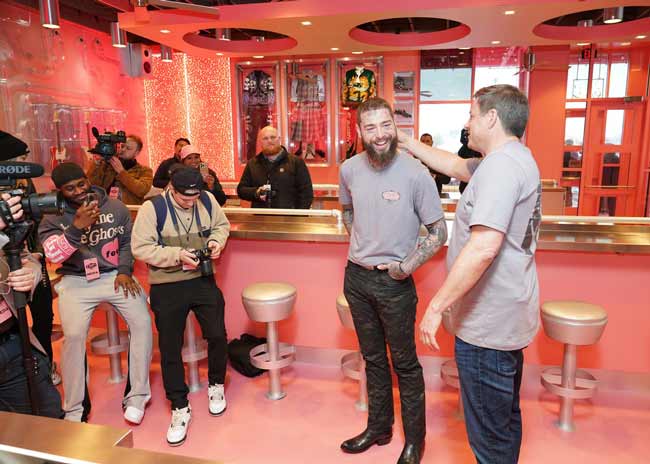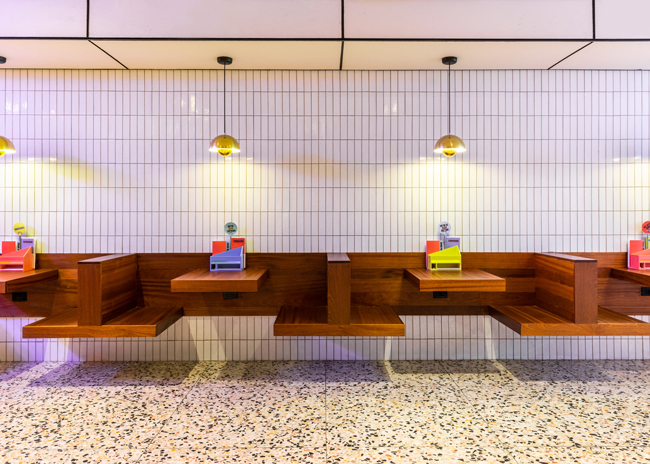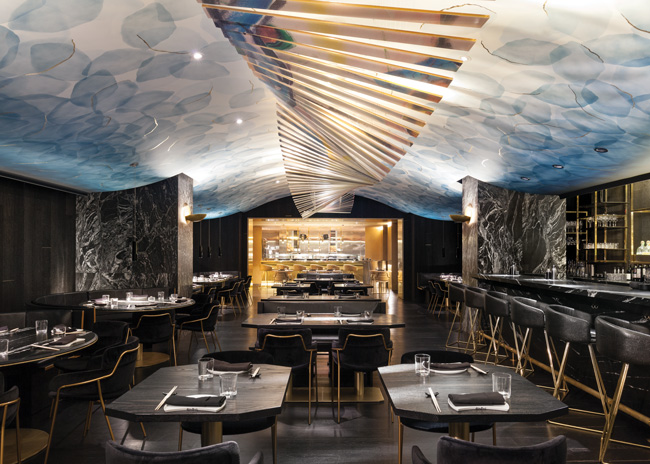 Caitlin Hubbs, Senior Designer, Aria GroupSelecting a cost-effective, on-trend mix of materials, finishes and furnishings for the casual-dining segment requires keeping a few key considerations in mind. Designers need to not only understand the particular brand and concept, of course, but also the rapidly changing dynamics within the segment and their implications for outfitting front-of-house spaces. Caitlin Hubbs, senior designer at Chicago-based Aria Group, which counts leading national, regional and local casual-dining brands among its client base, identifies five big concepts driving casual-dining design today.
Caitlin Hubbs, Senior Designer, Aria GroupSelecting a cost-effective, on-trend mix of materials, finishes and furnishings for the casual-dining segment requires keeping a few key considerations in mind. Designers need to not only understand the particular brand and concept, of course, but also the rapidly changing dynamics within the segment and their implications for outfitting front-of-house spaces. Caitlin Hubbs, senior designer at Chicago-based Aria Group, which counts leading national, regional and local casual-dining brands among its client base, identifies five big concepts driving casual-dining design today.
Flexibility. “Casual-dining operators have to accommodate a diverse set of user occasions. Some customers pick up and go, some hang out and socialize with family and friends, some visit the bar to watch the game, some dine alone and work. Meeting those diverse needs starts with seating plans and providing multiple types of seating arrangements,” Hubbs says. “We’ve been seeing a lot of focus on creating more separation within the plan for different seating groups and specifying everything from backless barstools and high-top communal tables in one area to lounge-style soft seating with high-quality materials in another area. We’re also seeing bigger demand for private rooms — not necessarily completely closed-off rooms, as you see in finer dining, but for flexible and transitional spaces that can be closed off if needed or that remain open but have a feeling of seclusion while still providing sight lines and the flow of energy from the main dining area beyond.”
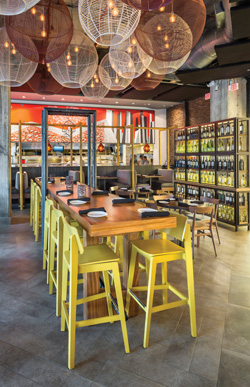 At a recently completed P.F. Chang’s unit in Santo Domingo, Dominican Republic, Aria’s team specified a variety of seating styles and contrasted natural furnishing and lighting materials with bold colors and artwork. Image courtesy of Fernando Calzada
At a recently completed P.F. Chang’s unit in Santo Domingo, Dominican Republic, Aria’s team specified a variety of seating styles and contrasted natural furnishing and lighting materials with bold colors and artwork. Image courtesy of Fernando Calzada
Solutions: varied seating and table styles, lighting control systems to change brightness and color temperatures throughout the day/for different occasions, screens and operable glazing systems, extra acoustic materials and built-in/hidden AV capabilities for private dining areas
Instagrammability. In casual dining, snapping and sharing photos is more socially acceptable than in some other segments, says Hubbs, so it’s more important than ever to design for 360-degree views rather than focusing on one key “glamour shot” area. She sees concepts opting for bolder colors and patterns, more art, stronger graphics, more localized designs and plenty of natural light. “And it’s also becoming more important to not just focus on photos but on video sharing as well. With the popularity of apps like Snapchat and Instagram video growing fast, we have to be more concerned about sound and acoustics. You don’t want a lot of echoing in the videos that guests are posting.”
Solutions: bold paint colors, distinctive wallcoverings, Instagram-worthy graphic messaging, sound-absorbing materials, strategic lighting and sound systems
Authenticity. As casual-dining operators work to increase menu transparency and incorporate more local, sustainable ingredients, parallel efforts are — or should be — happening on the design side, Hubbs says. “We emphasize the importance of carrying authenticity and transparency through to the materials specified — real wood tabletops and natural concrete, for example, and locally sourced items or art installations by local artists. Those types of things create a deeper connection and give meaning to place. It’s something that casual-dining operators rarely paid attention to but now need to incorporate in their designs in order to be competitive. And if you can’t be completely true to the natural material, you can now find lots of great ways to evoke it,” she adds. “Wood-look porcelain tile is a great example. It looks so natural, is super-durable and easy to maintain. If a painted wall mural isn’t durable enough, you can have a local artist create an image and then print it onto a washable wallcovering. There are a lot of ways to bring in art, the natural and the human aspect of the design and make it work in a casual-dining setting.”
Solutions: natural wood surfaces and millwork, concrete flooring, wood-look porcelain tile, ceramic tile, fabrics, custom-printed durable wallcoverings, natural stone and brick veneers
 At Baker's Crust in Ashburn, Va., the design called for casual, flexible, day-into-night solutions that support the concept's focus on quality ingredients, authentic preparations and attention to detail. Photo courtesy of Emilia Czader
At Baker's Crust in Ashburn, Va., the design called for casual, flexible, day-into-night solutions that support the concept's focus on quality ingredients, authentic preparations and attention to detail. Photo courtesy of Emilia Czader
Mobile Readiness. As mobile app takeout and delivery orders grow, so does the need for casual-dining operators to tap in and create both systems and designs that improve the odds of success. The challenge for designers is to create pickup areas for takeout and delivery orders that are convenient and intuitive for on-the-go guests to access and, if need be, to wait in, but that don’t detract from the dine-in experience. Some concepts now create separate, exterior pickup areas but Hubbs prefers to incorporate such areas into the interior design, specifying simple, durable materials there. “Keeping it part of the interior design, as a separate but integral feature, helps to cross-promote that revenue stream,” she says. “Guests see it as an option for another time or occasion, perhaps, but still have a very comfortable, dine-in experience.”
Solutions: signage and wayfinding, shelving, hot and refrigerated holding equipment, high-traffic/all-weather flooring, durable and easily cleanable finishes, compact seating options
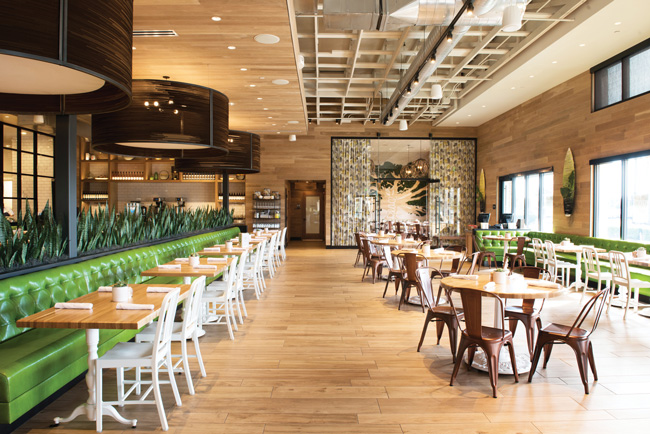 Aria used wood tables, wall and ceiling finishes, iron, metal, natural light and fresh greenery to create warm, brand-building ambiance at True Food Kitchen’s new Jacksonville Fla., unit. A separate but visually integrated area off the main dining room plays to the need for different and sometimes private dining experiences. Image courtesy of True Food Kitchen
Aria used wood tables, wall and ceiling finishes, iron, metal, natural light and fresh greenery to create warm, brand-building ambiance at True Food Kitchen’s new Jacksonville Fla., unit. A separate but visually integrated area off the main dining room plays to the need for different and sometimes private dining experiences. Image courtesy of True Food Kitchen
Seamless Tech Integration. It’s a fact of modern life that 24-7 digital access isn’t just what consumers want, it’s what they expect — including during visits to casual-dining restaurants. “There are so many demographics that use casual dining and so many types of user occasions that there’s a super-high need to have outlets and ports easily accessible from pretty much every seat,” Hubbs says. “We’re doing a lot of customized furnishings with built-in outlets and USB ports. Manufacturers are also starting to provide some good options but we need more. The demand is so high and isn’t going away.”
Solutions: mobile charging ports, wireless charging tabletops, tabletops with built-in charging ports, banquette bases with integrated outlets/ports

